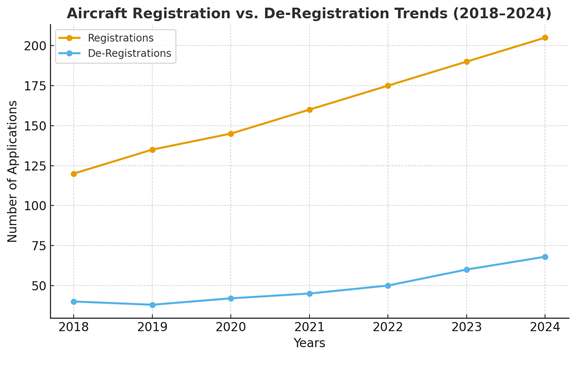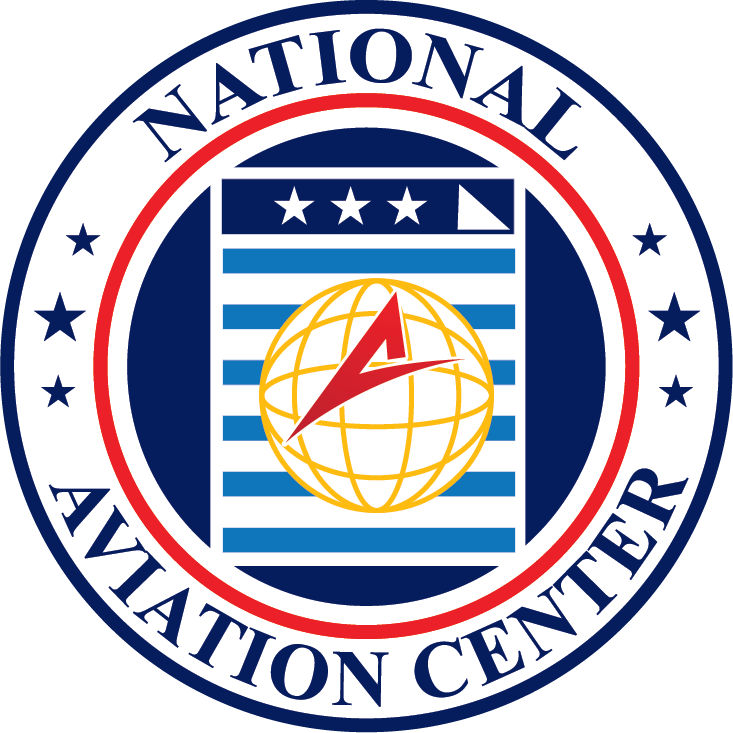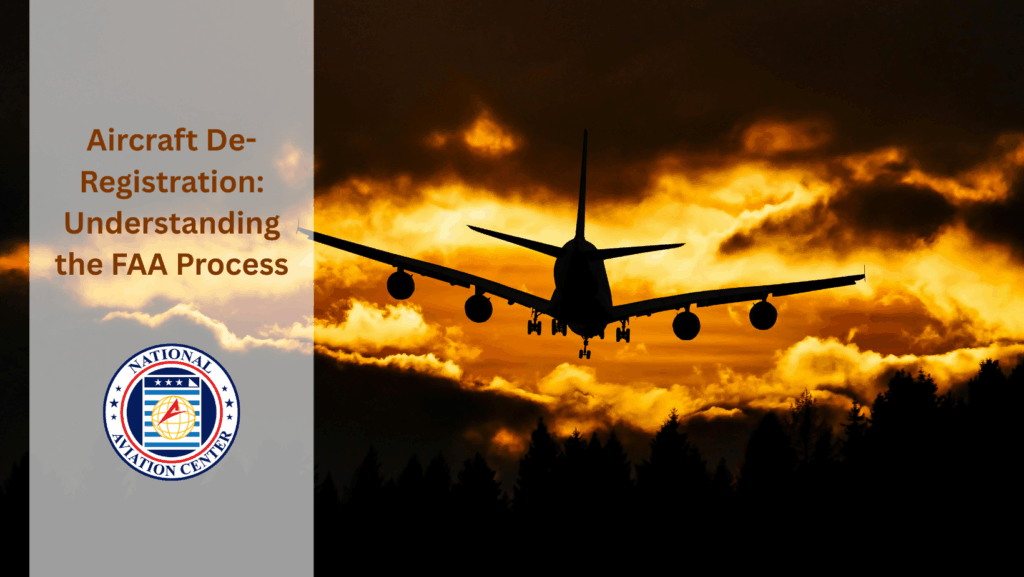Aircraft De-Registration is the removal of an aircraft from the FAA registry, a prerequisite to ensure that the aircraft is no longer legally associated with its last U.S. owner or registration status. De-Registration also occurs when an aircraft has been sold outside the country, destroyed, or is no longer airworthy.
If you are exporting your aircraft to a foreign country, or if your jet is coming to the end of its service and you need to de-register it, here is an explanation of the process, the documentation needed, and the difference between Registration and de-registration.
What Is Aircraft De-Registration and Why It Matters
Aircraft De-Registration is the process of removing an aircraft from the U.S. Civil Aircraft Registry by the FAA. Aircraft De-Registration is done in order to remove the aircraft from the registry and prevent future operation with that registration in the United States.
Importance of Aircraft De-Registration
- Legal compliance required prior to export or foreign transfer.
- Ownership Transfer Confirms release of U.S. ownership from FAA records.
- Insurance and Liability Protects prior owners against lawsuits or financial claims.
- International Operations needed re-registration with another country’s aviation authority.
The aircraft remains registered to its previous owner until de-registration, and its previous owner is still exposed to liability, taxes and operational disputes potentially.
The FAA Aircraft De-Registration Process
De-registration with the FAA is one of the first steps taken in the build-up of an aircraft’s legal history. If carried out incorrectly it may lead to legal issues or export delays.
Determine Eligibility for De-Registration
The aircraft has to meet at least one of:
- Sold to a foreign buyer.
- Destroyed or permanently damaged.
- Exported from the U.S.
- Dismantled or scrapped.
- Declared permanently inoperative.
Complete FAA Form 8050-2
The owner must include an FAA Form 8050-2 (Aircraft Bill of Sale) with the De-Registration Request Letter, which must contain:
- Aircraft registration number (N-number).
- Manufacturer and model.
- Serial number.
- Reason for de-registration (e.g. export, destruction, etc.).
- FAA maintains a record of the owner’s signature.
Submit to the FAA Aircraft Registry
After that, send the completed documents to the FAA Aircraft Registration Branch in Oklahoma City, which will review the documents to ensure the documents are accurate.
- Applications usually require 4 to 6 weeks to process.
- Completeness affects the time needed.
Receive FAA Confirmation
After processing from the FAA, the FAA will issue a De-Registration Notice confirming that the aircraft is no longer on the U.S. registry.
Detailed Aspects of Aircraft De-Registration
The de-registration process knowledge may prevent legal complications during international transfers.
Export and International Sale
Before registering it with another country’s aviation authority like EASA, Transport Canada, or CAAC, an aircraft being sold to a foreign buyer must de-register.
- It provides proof of sale and ownership.
- Delivery of an Export Certificate of Airworthiness upon request by the importing country.
- Coordinate with the FAA and the foreign civil aviation authority.
Destroyed or Dismantled Aircraft
The owners of an aircraft that is destroyed or permanently dismantled must below:
- A statement of destruction is required for the de-registration application.
- Return any remaining registration documents.
- Notify insurance companies and lienholders.
Condition Required Action
- Exported Provide buyer and country details
- Destroyed Include destruction certificate
- Dismantled Submit parts removal documentation
Understanding how de-registration differs from registration helps clarify the purpose of each.
| Aspect | Aircraft Registration | Aircraft De-Registration |
| Purpose | Legally adds aircraft to FAA registry | Officially removes aircraft from registry |
| When Required | Upon new ownership or import | Upon export, destruction, or sale abroad |
| Form Used | FAA Form 8050-1 | FAA Form 8050-2 and letter |
| Result | Aircraft gains legal status | Aircraft loses U.S. registration |
| Issued Document | Registration Certificate | De-Registration Notice |

- Registrations show a steady upward trend from 2018 to 2024.
- De-registrations remained relatively low but began increasing slightly in 2023–2024.
- The gap between registrations and de-registrations remains wide, indicating continued net fleet growth.
- Peak registration activity occurs in 2024 with the highest number of applications recorded.
This data reflects the growing global trading of aircraft with the expansion of private and commercial aviation worldwide.
Common Reasons for Aircraft De-Registration
- Export to Another Country: To register with another aviation authority.
- Permanent Loss or Destruction: In cases of accidents or severe damage.
- Fleet restructuring: When aircraft are retired or replaced.
- Change in Ownership Entity: Mergers, acquisitions, or financial restructuring.
| Scenario | FAA Action | Owner Responsibility |
| Export | De-register and provide new registry details | Submit export documents |
| Accident | Record and confirm loss | Submit destruction statement |
| Company Merger | Update ownership documentation | Reapply under new entity |
| Donation | De-register under donor’s name | Submit proof of transfer |
Legal and Financial Implications
Incorrectly completing or failing to complete the Aircraft De-Registration may incur penalties.
Potential Risks
- Tax Liabilities: Aircraft on the FAA registry may be subject to property or excise taxes.
- Insurance Complications: Some insurance policies may still be in old owners’ names.
- Operational Restrictions: Other authorities may refuse to register until the FAA de-registers the aircraft.
- Liability Exposure: Previous owners may have liability for incidents that occur after a sale.
FAA Enforcement
If someone violates 14 CFR Part 47, that person receives a civil penalty, the FAA possibly suspends the aeronautical certificate, and the FAA possibly grounds the aircraft for operating under fictitious or invalid registration.
Violation Consequence
- False Registration FAA penalties and revocation
- Failure to De-Register Liability for unauthorized use
- Failure to process submitted documentation on time
Practical Steps for a Smooth De-Registration
- Verify ownership records; names and signatures must match FAA documents.
- Prepare a complete document set at once. This can include Form 8050-2, a bill of sale, and a de-registration letter too.
- Coordinate with Foreign Authorities: Check on re-registration requirements.
- Retain Confirmation: Keep the FAA’s De-Registration Notice for legal protection.
Tip Purpose
- Keep copies of submissions for dispute prevention purposes.
- This early collaboration with the FAA avoids delays
- Examines compliance with export rules
- Notify lienholders Closes outstanding obligations
Successful De-Registration for International Transfer
When a U.S.-based charter company sold a mid-size business jet to a European operator, they submitted Form 8050-2, bill of sale, and export certificate to the FAA in order to meet the requirements for international acceptance.
Outcome:
- The FAA issued a notice of de-registration within four weeks.
- Within 10 days the buyer registered the aircraft with EASA.
- The parties complied – No delays occurred.
This case highlights the importance of documentation accuracy and communication between the two aviation authorities.
Streamlining Aircraft De-Registration for Legal and Safe Ownership Transfer
Completion of the Aircraft De-Registration step is commonly required for the transfer of aircraft, whether by sale, export, or retirement, in order to prevent future liability and maintain the accuracy of global records.
For Aircraft De-Registration at National Aviation Center, comply with all FAA procedural requirements and provide full and accurate paperwork; maintain contact with all involved parties to avoid needless delays.




